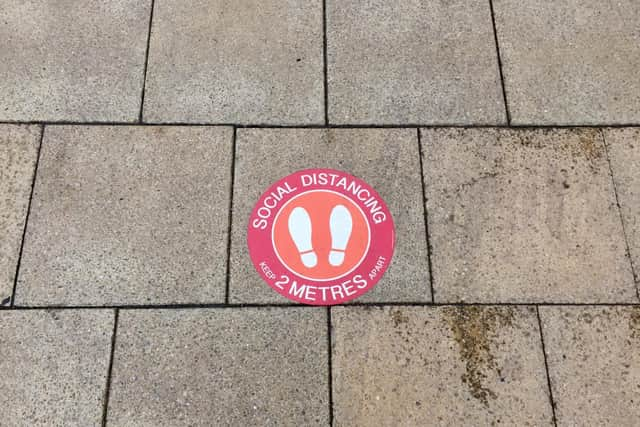Figures show where the coronavirus 'hotspots' are in Warwickshire
and live on Freeview channel 276
New coronavirus hotspots continue to develop across the UK, despite the introduction of testing and tracing systems.
Parts of England and Wales have seen the most new cases, with lower rates seen in Scotland and Northern Ireland.
Advertisement
Hide AdAdvertisement
Hide AdIn Warwickshire, two of the county's five districts - Nuneaton and Bedworth and North Warwickshire - feature in the top 40 'hotspots' - with Nuneaton and Bedworth in the top ten.


However, the Warwick district and the Stratford district feature much lower down the table, with the Rugby borough in around the middle of the table.
The figures are as follows:
Nuneaton and Bedworth (in 8th place in the English hotspot list, out of 313 local authorities)
Population: 129,883
Total coronavirus cases as of May 23: 408
Total coronavirus cases as of June 6: 456
Number of cases identified from May 23 to June 6: 48
Number of cases identified from May 23 to June 6, per 100,000 of the population: 37.0
Advertisement
Hide AdAdvertisement
Hide AdJPIMedia ranking as new English coronavirus hotspot (for cases in past fortnight): 8
North Warwickshire (in 31st place in the English hotspot list)
Population: 65,264
Total coronavirus cases as of May 23: 186
Total coronavirus cases as of June 6: 201
Number of cases identified from May 23 to June 6: 15
Number of cases identified from May 23 to June 6, per 100,000 of the population: 23.0
JPIMedia ranking as new English coronavirus hotspot (for cases in past fortnight): 31
Rugby borough (in 145th place in the English hotspot list)
Population: 108,935
Total coronavirus cases as of May 23: 186
Total coronavirus cases as of June 6: 194
Number of cases identified from May 23 to June 6: 8
Advertisement
Hide AdAdvertisement
Hide AdNumber of cases identified from May 23 to June 6, per 100,000 of the population: 7.3
JPIMedia ranking as new English coronavirus hotspot (for cases in past fortnight): 145
Warwick district (in 204th place in the English hotspot list)
Population: 143,753
Total coronavirus cases as of May 23: 291
Total coronavirus cases as of June 6: 298
Number of cases identified from May 23 to June 6: 7
Number of cases identified from May 23 to June 6, per 100,000 of the population: 4.9
Advertisement
Hide AdAdvertisement
Hide AdJPIMedia ranking as new English coronavirus hotspot (for cases in past fortnight): 204
Stratford district (in 211th place in the English hotspot list)
Population: 130,098
Total coronavirus cases as of May 23: 363
Total coronavirus cases as of June 6: 369
Number of cases identified from May 23 to June 6: 6
Number of cases identified from May 23 to June 6, per 100,000 of the population: 4.6
JPIMedia ranking as new English coronavirus hotspot (for cases in past fortnight): 211
Advertisement
Hide AdAdvertisement
Hide AdMonitoring the number of new infections plays an important part in measuring R, the reproduction rate of the virus.
The UK Government last month unveiled plans for “local lockdowns” in the next phase of the fight against the pandemic.
At a press briefing on Friday June 5, health secretary Matt Hancock said measures had since been put in place to dampen localised outbreaks, such as in Weston-Super-Mare, Somerset.
There, Weston General Hospital has been closed to new patients to control the spread of the virus among patients and staff.
Advertisement
Hide AdAdvertisement
Hide AdMr Hancock said it would be “increasingly important” to monitor data at local levels and then take action, a job which would fall to the new Joint Biosecurity Centre.
He said: “We need to get more granular and more focused and find the source of the local outbreak and then deal with it.”
The highest rates of new cases in the past fortnight were seen in Ashford and Tunbridge Wells in South East England, Huntingdonshire in the East of England and North Wales.
Each of these areas saw more than 50 new cases diagnosed for every 100,000 residents in the two weeks to June 6.
Advertisement
Hide AdAdvertisement
Hide AdIn Northern Ireland, the Causeway Coast and Glens council area saw the highest rate of new cases, at 29.8 per 100,000 residents, in the fortnight to June 6.
Speaking at a press conference on Tuesday (June 9), Northern Ireland health minister Robin Swann welcomed the nation’s third consecutive day without a coronavirus death.
But he warned of the chance of a second wave, saying: “There will be no charge for the lockdown exit door. There will be no suggestion that the worst is over, that people can relax their guard.
“Yes, Covid-19 is in retreat but we must not turn our back on it.”
Advertisement
Hide AdAdvertisement
Hide AdIn Scotland, the NHS Ayrshire and Arran area saw the highest rate of new cases, at 16.8 per 100,000 residents, in the fortnight to June 6.
Speaking at a press conference on Tuesday (June 9), first minister Nicola Sturgeon said the Scottish Government would in the coming weeks be publishing region-specific figures on the early stages of the country’s Test and Protect scheme.
She said: “I can’t stress enough that the willingness of all of us to fully co-operate with Test and Protect in the weeks and months to come will be absolutely vital to our efforts to keep the virus suppressed as we try to restore some normality to our everyday lives.”